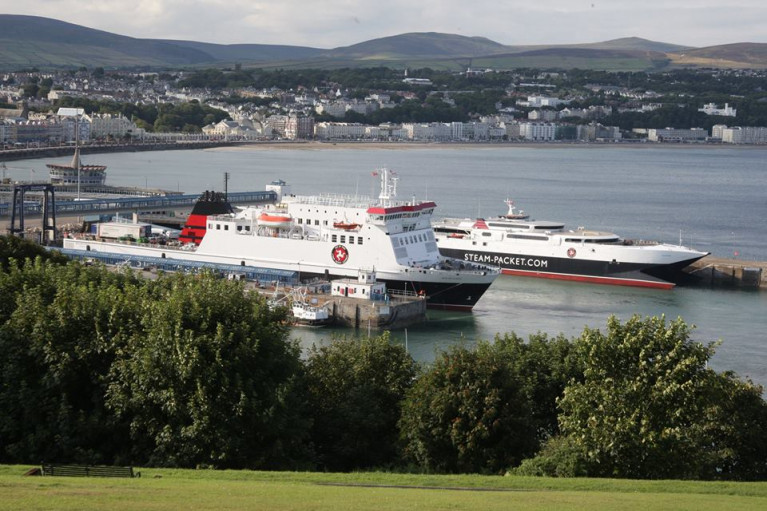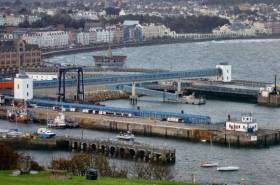Displaying items by tag: Douglas Harbour
Upgrade Works at Douglas Will Safeguard the Future Say Harbour Boss
A project to upgrade Douglas Harbour on the Isle of Man will according to the boss of the works "protect the infrastructure for the next 50 years".
Director of Harbours, David Gooberman said the harbour remained a "critical piece of infrastructure" and it and the new Isle of Man Steam Packet Company’s ferry Manxman (above pictured) at the King Edward VIII Pier needed to be protected.
The work which is to take place at the inner pier in Douglas, will see the project designed to keep the pier and the newbuild £76m ferry safe during gale force winds.
The walls of the pier will be repaired and fenders and mooring bollards replaced in a project which is to cost £6.61m. Work is to start this Saturday and is scheduled to last six months.
The new 950 passenger ferry, Manxman which last month entered service on the Douglas-Heysham route, is due to take over from the Ben-My-Chree as the company’s flagship vessel from October.
More from BBC News here.
Currently, both Manxman and Ben-My-Chree Afloat add, operate the main Isle of Man-England route using the King Edward VIII pier, with the newbuild running day time sailings and the existing flagship providing night-time crossings.
While fast-ferry Manannan maintains the link to Liverpool but using the adjacent Victoria Pier, where on the outside of the port’s main pier, is a layover berth. From there, the new and old ferries shift berths in between operating sailings based out of the King Edward VIII Pier.
British Royal Navy Minehunter Visits Douglas Harbour
A British Royal Navy minehunter HMS Brocklesby, Manx Radio reports had arrived in Douglas Harbour today.
It was a morning arrival for the Royal Navy minehunter to the Manx capital as the visiting vessel berthed alongside the harbour's Victoria Pier.
HMS Brocklesby is a 'Hunt' class mine-counter measures vessel (MCMV) which has the primary purpose to neutralise mines at sea.
This involves locating and neutralising sea mines using a combination of sonar, mine clearance divers and use of a remotely operated vehicle (ROV) the 'Seafox'.
The minehunter's homeport is Portsmouth, the the UK's biggest naval base.
Another former member of the Hunt-class, HMS Atherstone, Afloat reported earlier this year when Harland & Wolff acquired from the Ministry of Defence (MoD) with a view to refurbishing it for non-military uses.
Afloat also adds that HMS Brocklesby made a first visit to Dublin Port which took place in 1995 whereas HMS Ramsey paid a visit more recently in 2016.
Repairs in Douglas Harbour Needed to Protect Newbuild Ferry from Storms
Douglas Harbour is to undergo major works that are needed to protect the new Isle of Man Steam Packet ferry, the infrastructure minister has said.
Chris Thomas said the project would reduce the risk of damage to the Manxman and the harbour in high winds.
The plans would see repairs to the walls of King Edward VIII Pier and fenders and mooring bollards replaced.
The proposed works are scheduled to start in later summer next year and be completed ahead of the winter.
Construction works, which would take place around scheduled ferry sailings, would make sure the new larger vessel was "well-protected heading into the winter months", Mr Thomas said.
Under construction in South Korea, the Manxman will be 26ft (8m) longer than Ben-my-Chree and is due to come into service in spring.
More details writes BBC News on the new installations required to berth the newbuild.
Northern Lighthouse Board's NLV Pharos, one of two ships that service and maintain lighthouses and marine Aids to Navigation in Scotland and the Isle of Man, will be in Douglas Harbour to hold Open Days for the public this weekend (23-24 July).
NLV Pharos will be berthed in the Manx capital alongside the Victoria Pier with free ship tours from 2 pm to 4 pm. This will enable the public to get a chance to board the aids to navigation ship, meet the crew and find out about their work as part of the Northern Lighthouse Board.
Mike Bullock, NLB’s Chief Executive, said: “This is a rare opportunity for the public to come on board and to meet the crew. Visitors will get a real insight into our operations and vital safety service for mariners in Scottish and Isle of Man waters. We know Pharos is often seen in Manx waters, but this is a chance to get onboard our most modern vessel. The open days are a welcome opportunity for NLB to forge links with the local community and showcase what we do.”
The homeport of NLV Pharos is Oban, in west Scotland, and the vessel works mainly in Scottish and Isle of Man waters. In addition to the ship’s primary role in responding to wrecks and new navigational dangers, this highly sophisticated vessel supports maintaining and refurbishing NLB’s 200-plus lighthouses and conducting buoy operations.
NLV Pharos came into service in 2007 and is equipped with a helicopter pad, dynamic positioning, a 30 Tonne crane and a hydrographic survey suite.
In recent months, Afloat reported on the dry-docking 'Special Survey' of the NLV Pharos, which took place at Harland & Wolff's Belfast shipyard.
Due to ongoing problems in Douglas Harbour, the Isle of Man Steam Packet's sailing timetables for its ferry services have been revised.
The fast-craft Manannan will run two daytime sailings (today, 31 March) instead of the ro-pax Ben-my-Chree, departing at 9:30am for Heysham, and returning at 2:15pm.
According to Manx Radio, this will continue for the next three days (incl. Easter Saturday, 3rd April).
Ferry company boss Mark Woodward says the adjustments have been made to avoid on confusion in the coming days.
All passengers who're affected by the changes are asked to contact the Steam Packet Reservations Team on 661661.
A full list of the changes can be consulted through the Steam-Packet's website here, where the operator also outlines the combined reasons for problems in the harbour.
Sailings Cancelled As Silt Builds up in Douglas Harbour
Ferry sailings of the Isle of Man Steam Packet were called off for the ro-pax Ben-my-Chree.
Sailings to and from the Island, reports Manx Radio, have been cancelled due to silt build up in Douglas Harbour.
The Steam Packet Company has pulled the 8.45am, Ben-my-Chree, crossing to Heysham and the return journey at 2.15pm.
It says the silt combined with an extremely low tide is to blame.
Overnight sailings were also affected with the Ben-my-Chree delayed leaving Heysham.
It's due back to Douglas at 10am, meaning today's newspapers will be late.
#FerryNews - IOM Today reports of a newly-formed lobby group that says it has ’serious concerns’ about the ’strategic vulnerablility’ of Douglas port.
Isle of Man Maritime Ltd, a not-for-profit company which has replaced the Isle of Man Shipping Association, points out the harbour is too small to handle the larger roll-on, roll-off vessels that are now the norm.
And it says there is no contingency plan should there be a serious incident in the harbour which blocks it to other sea traffic.
It issued the statement after Tynwald last month backed an £80m strategy to redevelop Douglas harbour and attract more cruise liners to the island.
The Shipping Association had proposed a £35m-40m scheme for a fixed deep water landing stage on the seaward-side of the breakwater that protects Douglas harbour.
For further reading of this development, click here.


























































